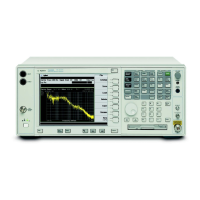Chapter 3 79
Making Measurements
Tuned RF Level Measurement
NOTE Do not Preset the PSA, or use the Frequency Counter function. If you do, the
instrument will require at least 30 minutes for stabilization.
Step 8. Perform the following steps for each measurement value:
1. Decrease the source power level to the next lower setting and press the
Restart
key.
NOTE Since the PSA will automatically change ranges and calibrate the ranges as
needed, use step sizes of 10 dB or less.
2. Record the Tuned RF Level result.
3. Continue decreasing the source level and repeating steps 1 and 2.
4. When the source level reaches a power level where the PSA requires the Range
2 change, your measurement will be interrupted and a range calibration will
occur. This range calibration will only occur the first time you perform the
measurement at a particular frequency and power level using the current PSA
settings. There will be no Cal Factor 1 value shown on the display.
If any PSA settings such as IF BW, or if the input frequency is changed, a new
range calibration will be required.
5. Continue decreasing the source level and repeating steps 1 and 2.
6. When the source level reaches a power level where the PSA requires the Range
3 change, your measurement will be interrupted and a range calibration will
occur.
7. When all source levels have been measured, calculate the TRFL measurement
error. See the Measuring Receiver Personality specifications in the PSA
Specification Guide. The Relative Measurement Accuracy specification
applies.
NOTE If you wish to start a new series of measurements, and want to clear the Cal Factor
values, press
Measure Setup, and toggle the IF BW to 75 Hz then back to 10 Hz.
Press Set Reference again.
NOTE If the frequency setting of the measurement is changed you must clear the Cal
Factor values and recalibrate the ranges at the new frequency.

